Introduction
If you’re faced with buying a new router today, a key fork in the decision making road is whether to go for an N or AC class router. My advice until now has been to stay with a cheaper N router if you don’t have AC devices because AC routers offer little to no performance advantage.
However, despite this advice, I keep seeing people raving about improved performance they got from moving up to an AC router. Will A New Router Really Improve Performance? Part 2 looked at wireless throughput using various combinations of AC, N and even "legacy" (802.11a/g) routers and clients. However, in an effort to minimize differences in RF characteristics that could skew the results, the N and "legacy" devices were simulated by manipulating the wireless mode controls on an ASUS RT-AC66U router and USB-AC56 adapter.
So I decided to take another look, using a more straightforward approach, i.e. one N device and seven AC routers. What I found has changed my advice about AC routers and N devices.
The Method
The approach was simple. The test client was an Acer Aspire S7 Ultrabook running Windows 8 with an Intel Dual Band Wireless N 7260 Plus Bluetooth adapter with 16.5.3.6 Win 8 64 bit driver. This 2×2 N600 class adapter is found in many notebooks and has the advantage of not providing a performance edge to any router because Intel isn’t used in consumer routers. 2×2 adapters in general, either single or dual-band, are also commonly included in many notebooks.
I chose the top-ranked ASUS RT-N66U as the reference N router to provide nice high N results as a comparison baseline. To keep testing manageable, I ran up and downlink open air tests in only one location, with the router in my downstairs corner office and the client in Location D.
The diagram below shows Location D on the upper level of an approximately 3300 square foot two-level home, approximately 35 feet away (direct path) from the router. There is one wood floor, one lower level sheetrock wall and a sheetrock ceiling between router and Client.
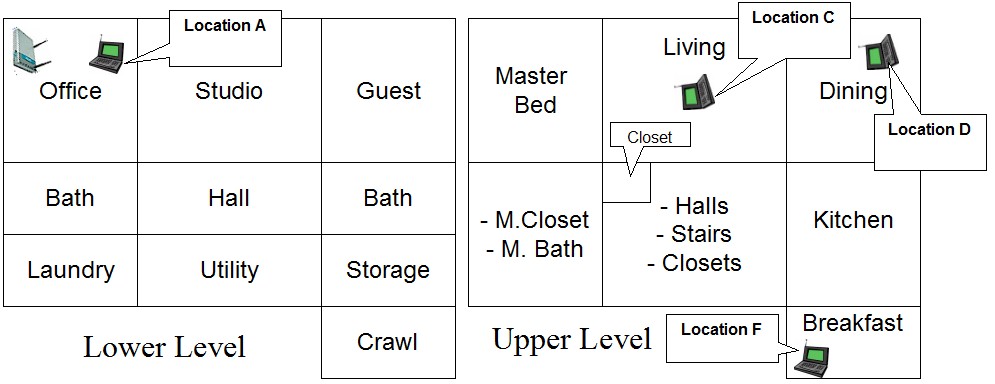
Test Locations
This location was chosen because it represents a mid-signal "transition" location for 2.4 GHz and the furthest operable 5 GHz location; precisely the kind of location where you would want to see a performance improvement from buying a new router.
Each 90 second test was run once and there were no other networks active during testing. As is our standard practice, WPA2/AES encryption was used for all testing with channel 6 and 20 MHz mode used in 2.4 GHz and channel 153 and Auto mode used in 5 GHz.
I tried the assortment of top-performing AC routers summarized in Table 1, including AC1750, AC1900 and even the newer AC2350 and AC3200 classes. All were loaded with latest firmware before testing.
| Router | Firmware | Class | Processor |
|---|---|---|---|
| ASUS-RT-N66U (reference) | 3.0.0.3.376_1071 | N900 | Broadcom BCM4706 |
| ASUS RT-AC66U | 3.0.0.4.376_1123 | AC1750 | Broadcom BCM4706 |
| ASUS RT-AC68U | 3.0.0.4.376_1663 | AC1900 | Broadcom BCM4708A |
| ASUS RT-AC87U | 3.0.0.4.376_2061 | AC2350 | Broadcom BCM4709A |
| Linksys WRT1900AC | 1.1.8.161917 | AC1900 | Marvell MV78230 Armada XP |
| NETGEAR R6300V2 | V1.0.3.8_1.0.60 | AC1750 | Broadcom BCM4708A |
| NETGEAR R7000 | V1.0.3.68_1.1.31 | AC1900 | Broadcom BCM4709A |
| NETGEAR R8000 | V1.0.0.102_1.0.45 | AC3200 | Broadcom BCM4709A |
Table 1: Routers and firmware
I did not monitor link rate or RSSI during testing, because both are only indirect indications of performance and vary greatly from device to device. Telling you I measured an RSSI of -60 dBm means little because your environment (router, device, physical environment, RF environment) is different than mine. In the end, it’s delivered throughput that matters, so that’s what I measured.
I will share that using inSSIDer I measured path losses of approximately 17 dB in 2.4 GHz and 36 dB in 5 GHz between the reference RT-N66U and notebook in Location D.
The Results
The percentage difference between the throughput measured using the RT-N66U N reference router and the router under test was calculated. Results were then plotted for each band and traffic direction. Each downlink plot sorts the results from best to worst. But uplink plots keep the same device order so that you can quickly see differences between two directions.
If you want to do the math, the reference throughput measurements were: 2.4 GHz dn – 28.5 Mbps; 2.4 GHz up – 32.2 Mbps; 5 GHz dn – 18.3 Mbps; 5 GHz up – 14.6 Mbps.
Starting with 2.4 GHz downlink, we see impressive gains from ASUS’ AC1900 and new AC2350 routers. The newer NETGEAR R8000 AC3200 turns in the next best performance with a 165% gain. The least improvement was provided by Linksys’ top-of-line WRT1900AC, with only 58%.
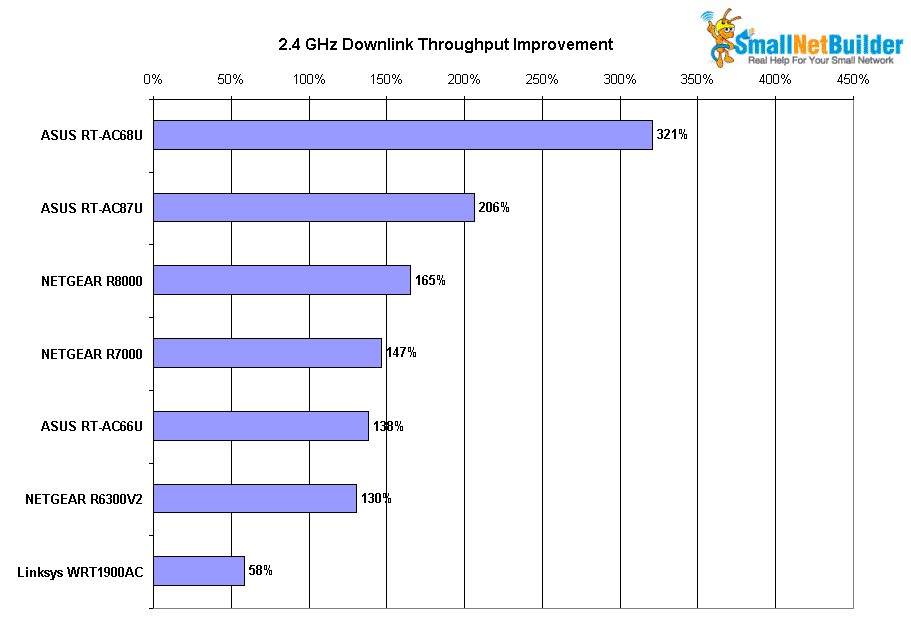
2.4 GHz Downlink Throughput Improvement
I have yet to find a router that is an all-around winner in both bands and both directions and the 2.4 GHz uplink results reflect this. At least the ASUS RT-AC68U and RT-AC87U keep their same relative positions, if you ignore the 3% difference between them. At the bottom of the chart, the Linksys’ throughput improvement is a more impressive 130%, virtually tieing the NETGEAR 6300 v2, which provided more than twice the WRT1900AC’s improvement on downlink.
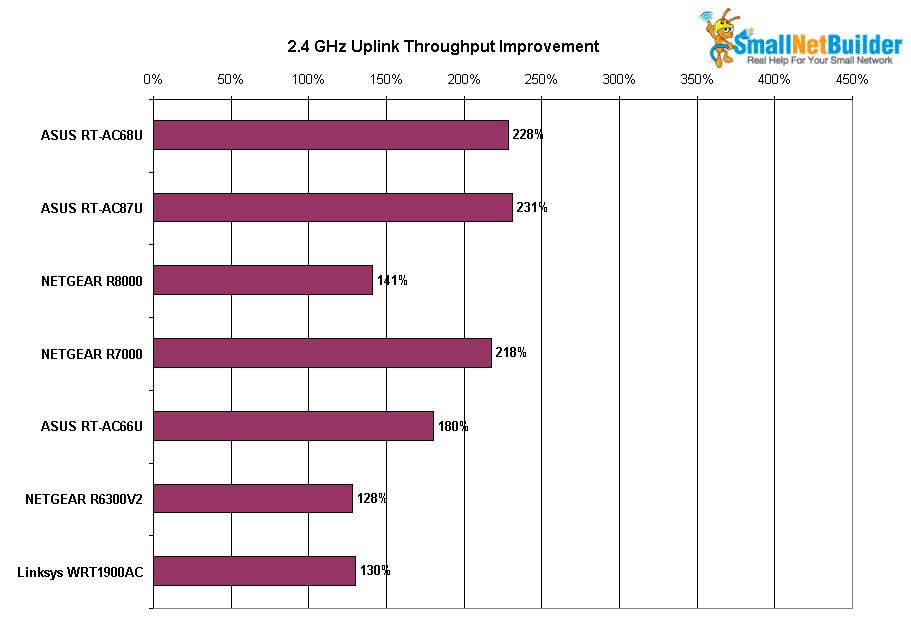
2.4 GHz Uplink Throughput Improvement
The 5 GHz downlink results are quite surprising. First, the overall improvements are much higher than the 2.4 GHz results, with best case improvements over 400%! In keeping with my no-all-around-router-winner rule, the routers with some of the lowest 2.4 GHz improvements—Linksys’ WRT1900AC and NETGEAR’s R6300v2—provide the highest 5 GHz improvements!
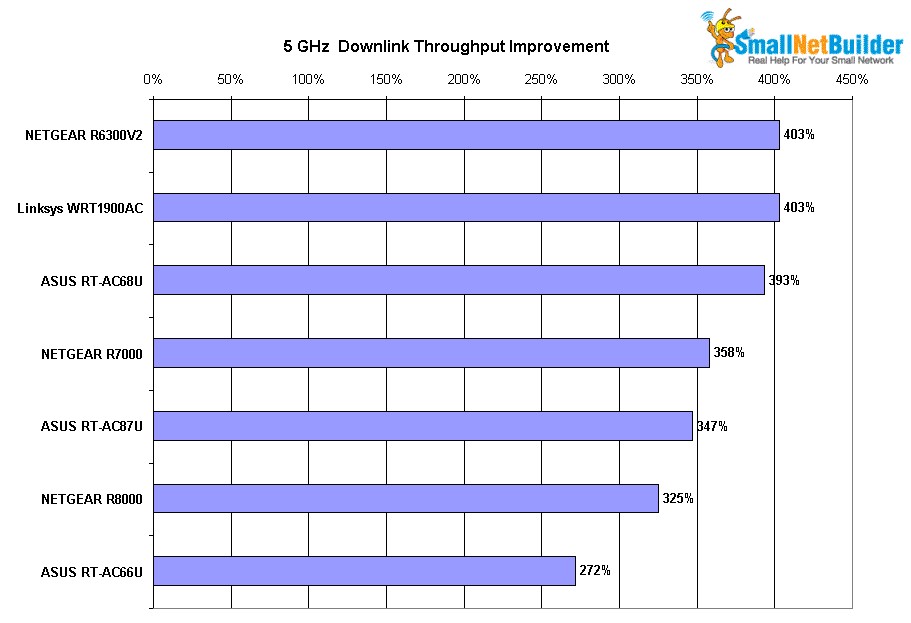
5 GHz Downlink Throughput Improvement
Throughput gains generally fall back for 5 GHz uplink, with two different routers—ASUS RT-AC87U and NETGEAR’s R7000—taking the top positions. Still, a minimum gain of 182% is significant.
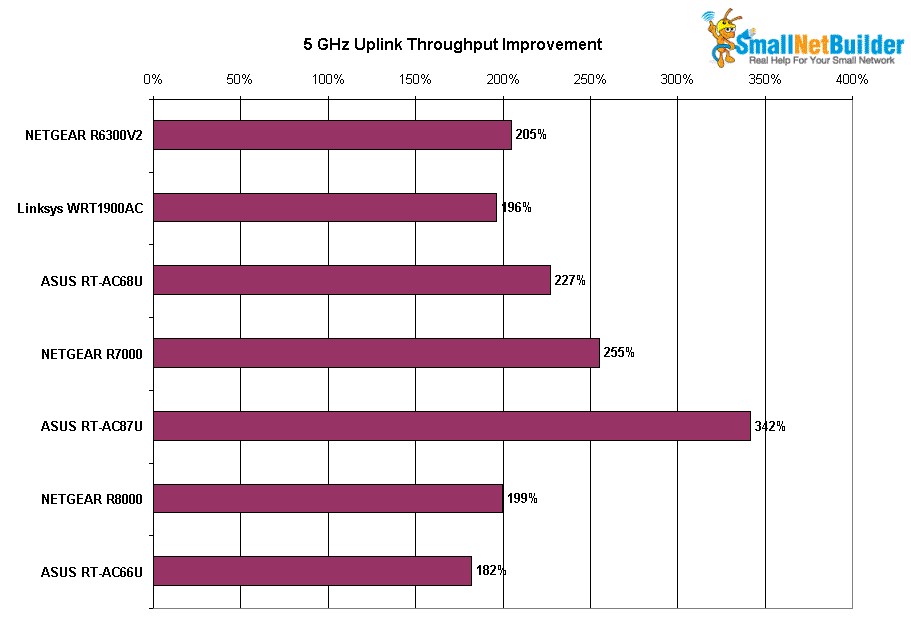
5 GHz Uplink Throughput Improvement
Closing Thoughts
I’m surprised by the results in a few ways. First, I didn’t expect such significant improvement, especially for 2.4 GHz. The 2.4 GHz side of AC routers is good ol’ 802.11n, at least before AC1900 and higher class products "enhanced" it with the non-standard addition of QAM-256 modulation. But our N600 Intel client can’t even take advantage of the reference N900 router’s maximum 217 Mbps link rate (in 20 MHz), so AC1900 doesn’t make a difference either.
Faster processors also don’t seem to be the key. The AC1750 ASUS RT-AC66U uses the same Broadcom BCM4706 as the reference N900 class ASUS RT-N66U. But the AC66U provided at least a 180% performance boost on both bands and 272% for 5 GHz downlink!
While moving from N to AC provided a significant increase in throughput in our mid-level signal location, higher price wasn’t a predictor of higher performance. 5 GHz throughput gain from the latest and greatest (and most expensive) NETGEAR R8000 and ASUS RT-AC87U was either the same or lower than provided by the NETGEAR R6300 v2 at around half the cost. In only one case—5 GHz uplink—did the AC87U provide the best throughput improvement.
One improvement none of these routers provided was range extension, at least not in the sense of the ability to reach the Location F 5 GHz dead zone. I ran a quick check by starting a long ping in Location D and walking the ultrabook over to Location F. The Linksys, both NETGEAR routers and ASUS RT-AC68U were able to remain connected at a 6 Mbps link rate, but with ping failing. All the others disconnected.
By the way, I would have run tests with lower cost AC1200 routers, but found I had given them all away! Maybe next time.
So I’m not saying an AC router will cure all your Wi-Fi ills. I have only to glance through the SNB Forums to see plenty of complaints that device X doesn’t play nicely with someone’s shiny new AC router. But there’s enough evidence in this little experiment to say that moving up to an AC router, even if you have only N devices, could pay off in a speedier wireless network. I’m going for a nice crow dinner now…
